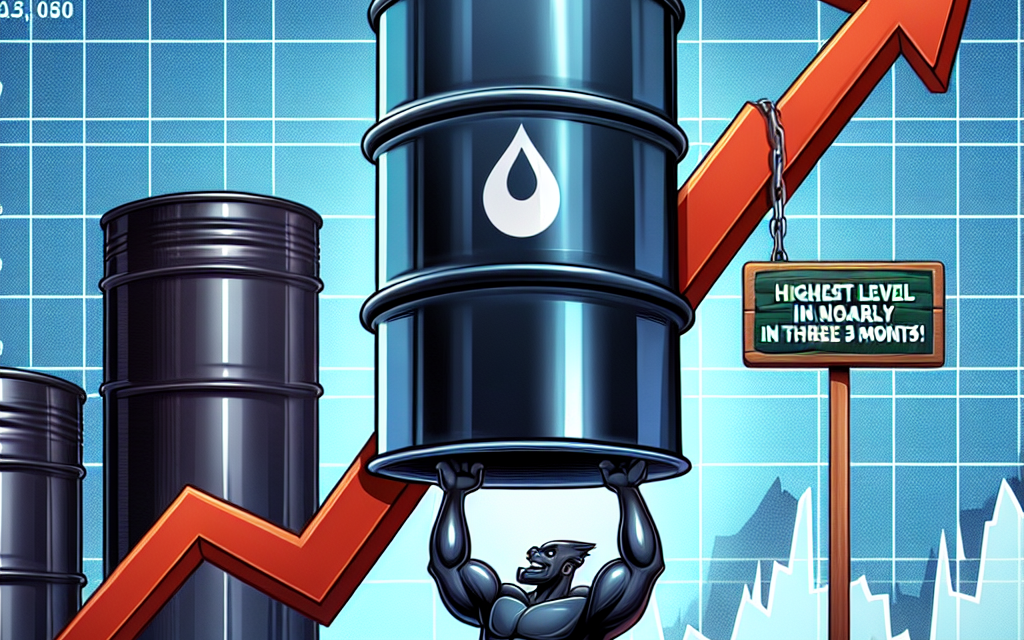“Oil Futures Surge to Three-Month Highs, Signaling Market Resilience.”
Introduction
Oil futures closed at their highest level in nearly three months, driven by a combination of factors including supply constraints, geopolitical tensions, and increasing demand forecasts. Market participants reacted to reports of production cuts from major oil-producing nations and concerns over potential disruptions in supply chains. Additionally, a rebound in global economic activity has fueled optimism for higher consumption, further supporting prices. This upward trend reflects the ongoing volatility in the energy market and highlights the critical role of geopolitical dynamics in shaping oil prices.
Oil Futures Surge: Key Factors Behind the Rise
Oil futures have recently surged, closing at their highest level in nearly three months, a development that has captured the attention of investors and analysts alike. This significant increase can be attributed to a confluence of factors that have influenced market dynamics, leading to heightened demand and constrained supply. As the global economy continues to recover from the impacts of the pandemic, the demand for oil has rebounded, particularly in key markets such as the United States and China. This resurgence in consumption has been driven by increased industrial activity and a rise in travel, both of which have contributed to a more robust appetite for energy resources.
Moreover, geopolitical tensions have played a pivotal role in shaping the oil market landscape. Ongoing conflicts in oil-producing regions, particularly in the Middle East, have raised concerns about potential supply disruptions. These uncertainties have prompted traders to factor in the risk of supply shortages, thereby driving prices higher. Additionally, the recent decision by OPEC+ to maintain production cuts has further tightened the supply chain, reinforcing the upward pressure on oil prices. By limiting output, OPEC+ has effectively managed to stabilize the market, ensuring that demand outpaces supply, which has been a critical factor in the recent price surge.
In conjunction with these geopolitical and supply-side factors, the broader economic context cannot be overlooked. The global economy is experiencing a phase of recovery, characterized by increased consumer spending and investment. As countries emerge from the constraints imposed by the pandemic, the demand for energy has surged, leading to a more competitive market environment. This recovery has been particularly pronounced in sectors such as transportation and manufacturing, both of which are heavily reliant on oil. Consequently, as businesses ramp up operations and consumers return to pre-pandemic behaviors, the demand for oil has surged, further propelling prices upward.
Furthermore, the influence of financial markets should also be considered. Speculative trading has intensified as investors seek to capitalize on the rising prices. The influx of capital into oil futures has created a self-reinforcing cycle, where rising prices attract more investment, which in turn drives prices even higher. This phenomenon has been exacerbated by the low-interest-rate environment, which has encouraged investors to seek higher returns in commodities like oil. As a result, the interplay between speculative trading and fundamental supply-demand dynamics has contributed to the recent surge in oil futures.
In addition to these factors, the ongoing transition towards renewable energy sources has also had an impact on the oil market. While this transition is expected to take time, the anticipation of future regulatory changes and shifts in consumer preferences has led to increased volatility in oil prices. Investors are closely monitoring these developments, as they could influence long-term demand for fossil fuels. However, in the short term, the current market conditions suggest that oil will remain a critical component of the global energy landscape.
In conclusion, the recent surge in oil futures, culminating in their highest closing levels in nearly three months, can be attributed to a complex interplay of recovering demand, geopolitical tensions, supply constraints, and speculative trading. As these factors continue to evolve, market participants will remain vigilant, closely watching for any signs that could signal a shift in this dynamic landscape. The oil market, with its inherent volatility and sensitivity to global events, will undoubtedly continue to be a focal point for investors and analysts in the coming months.
Market Reactions: What the Highest Oil Futures Mean for Investors
The recent surge in oil futures, which closed at their highest level in nearly three months, has sent ripples through the financial markets, prompting investors to reassess their strategies and outlooks. This upward movement in oil prices can be attributed to a confluence of factors, including geopolitical tensions, supply chain disruptions, and a recovering global economy. As these elements converge, they create a complex landscape for investors who must navigate the implications of rising oil prices on various sectors and asset classes.
Firstly, the increase in oil futures often signals a tightening supply situation, which can lead to higher costs for businesses reliant on oil and gas. For instance, transportation and manufacturing sectors are particularly vulnerable to fluctuations in oil prices, as fuel costs constitute a significant portion of their operational expenses. Consequently, companies in these industries may face pressure to pass on increased costs to consumers, potentially leading to inflationary pressures. Investors should be mindful of how these dynamics could affect corporate earnings and stock valuations, particularly in sectors that are heavily dependent on oil.
Moreover, the rise in oil prices can also influence the broader economic landscape. Higher oil prices typically lead to increased revenues for oil-producing nations and companies, which can stimulate investment in energy infrastructure and exploration. This, in turn, may create opportunities for investors in the energy sector, particularly in stocks of companies engaged in oil extraction and production. As these companies benefit from higher margins, they may also increase dividends or reinvest in growth initiatives, making them attractive options for income-focused investors.
In addition to direct investments in energy stocks, the implications of rising oil prices extend to commodities and alternative energy investments. As oil becomes more expensive, investors may seek to diversify their portfolios by exploring other energy sources, such as renewables. This shift could lead to increased capital flows into solar, wind, and other alternative energy projects, which are gaining traction as viable long-term investments. Consequently, investors should consider the potential for growth in these sectors as they respond to changing energy dynamics.
Furthermore, the impact of rising oil prices is not limited to the energy sector alone; it also reverberates through the financial markets as a whole. For instance, higher oil prices can lead to increased volatility in equity markets, as investors react to the potential for inflation and its implications for monetary policy. Central banks may be compelled to adjust interest rates in response to rising inflationary pressures, which can have far-reaching effects on borrowing costs and consumer spending. Therefore, investors must remain vigilant and consider how changes in monetary policy could influence their investment strategies.
In conclusion, the recent highs in oil futures present both challenges and opportunities for investors. While rising oil prices can lead to increased costs for certain sectors and potential inflationary pressures, they also create avenues for growth in the energy sector and alternative investments. As the market continues to react to these developments, investors must stay informed and agile, adapting their strategies to navigate the complexities of a changing economic landscape. By doing so, they can position themselves to capitalize on the potential benefits while mitigating the risks associated with fluctuating oil prices.
Economic Implications of Rising Oil Futures Prices
The recent surge in oil futures prices, which have closed at their highest level in nearly three months, carries significant economic implications that extend beyond the energy sector. As oil prices rise, they influence a myriad of economic factors, including inflation, consumer spending, and overall economic growth. Understanding these dynamics is crucial for policymakers, businesses, and consumers alike.
To begin with, rising oil prices often lead to increased costs for transportation and production. This is particularly evident in industries that rely heavily on oil, such as logistics, manufacturing, and agriculture. As these costs escalate, businesses may be compelled to pass on the expenses to consumers in the form of higher prices for goods and services. Consequently, this can contribute to inflationary pressures within the economy. When consumers face higher prices, their purchasing power diminishes, which can lead to a decrease in overall consumer spending. This reduction in spending can have a ripple effect, slowing economic growth and potentially leading to a contraction in certain sectors.
Moreover, the impact of rising oil prices is not uniform across all sectors of the economy. While some industries may struggle with increased operational costs, others, particularly those involved in oil extraction and production, may experience a boost in profitability. This divergence can create a complex economic landscape where certain regions or sectors thrive while others face challenges. For instance, areas heavily reliant on oil production may see job growth and increased investment, while regions dependent on manufacturing or transportation may experience layoffs and reduced economic activity.
In addition to affecting businesses and consumers, rising oil prices can also influence monetary policy decisions made by central banks. As inflationary pressures mount due to higher energy costs, central banks may feel compelled to adjust interest rates to maintain price stability. Higher interest rates can further dampen consumer spending and business investment, creating a delicate balancing act for policymakers. The challenge lies in addressing inflation without stifling economic growth, a task that becomes increasingly difficult in an environment of rising oil prices.
Furthermore, the geopolitical implications of rising oil prices cannot be overlooked. Fluctuations in oil prices often reflect broader geopolitical tensions, particularly in oil-producing regions. As prices rise, they can exacerbate existing conflicts or create new ones, as nations vie for control over valuable resources. This can lead to increased volatility in global markets, further complicating the economic landscape. Investors may react to these uncertainties by adjusting their portfolios, which can lead to fluctuations in stock markets and other asset classes.
In light of these factors, it is essential for stakeholders to remain vigilant and adaptable in response to rising oil futures prices. Businesses may need to explore strategies to mitigate the impact of increased costs, such as investing in energy-efficient technologies or diversifying supply chains. Consumers, on the other hand, may need to adjust their spending habits in response to higher prices, prioritizing essential goods and services over discretionary spending.
In conclusion, the recent rise in oil futures prices presents a multifaceted challenge for the economy. From inflationary pressures to shifts in consumer behavior and potential changes in monetary policy, the implications are far-reaching. As the situation evolves, it will be crucial for all economic participants to navigate these changes thoughtfully, ensuring resilience in the face of fluctuating energy prices.
Historical Trends: Comparing Current Oil Futures to Past Peaks
Oil futures recently closed at their highest level in nearly three months, prompting a closer examination of historical trends and how current prices compare to past peaks. Understanding these fluctuations requires a look back at the factors that have historically influenced oil prices, as well as the broader economic context in which these changes occur.
Historically, oil prices have been subject to a variety of influences, including geopolitical tensions, supply and demand dynamics, and shifts in global economic conditions. For instance, during the early 2000s, oil prices began a significant upward trajectory, driven largely by increasing demand from emerging economies, particularly China. This period saw oil futures reach unprecedented levels, culminating in a peak of over $140 per barrel in mid-2008. However, this surge was followed by a dramatic collapse, as the global financial crisis led to a sharp decline in demand and prices plummeted to around $30 per barrel by early 2009.
In the years that followed, oil prices experienced a series of peaks and troughs, influenced by various factors such as OPEC’s production decisions, technological advancements in extraction methods, and the rise of alternative energy sources. For example, the shale oil boom in the United States significantly altered the landscape of global oil supply, leading to a period of lower prices from 2014 to 2016. During this time, oil futures fell below $30 per barrel again, highlighting the volatility inherent in the market.
As we compare the current surge in oil futures to these historical peaks, it is essential to consider the underlying causes of the recent price increase. Factors such as ongoing geopolitical tensions in key oil-producing regions, supply chain disruptions, and the recovery of global demand post-pandemic have all contributed to the current market dynamics. Moreover, the recent decision by OPEC+ to cut production has further tightened supply, pushing prices upward. This situation mirrors past instances where coordinated production cuts by oil-producing nations have led to significant price increases.
Furthermore, the current economic environment, characterized by inflationary pressures and rising energy costs, has also played a crucial role in shaping oil futures. As consumers and businesses grapple with higher prices across various sectors, the demand for oil remains resilient, particularly as economies continue to recover from the impacts of COVID-19. This resilience is reminiscent of previous periods when oil prices surged in response to strong demand, despite broader economic challenges.
In light of these historical trends, it becomes evident that while current oil futures are indeed at their highest level in nearly three months, they are part of a larger narrative of volatility and fluctuation that has defined the oil market for decades. As we look ahead, it is crucial to remain vigilant about the factors that could influence future price movements. Whether it be geopolitical developments, changes in production levels, or shifts in consumer behavior, the oil market will undoubtedly continue to evolve. Thus, understanding these historical patterns not only provides context for current prices but also serves as a reminder of the complexities that underpin the global oil economy. As such, stakeholders must navigate this landscape with a keen awareness of both past trends and emerging challenges.
Geopolitical Influences on Oil Futures and Market Stability
In recent weeks, oil futures have experienced a notable surge, closing at their highest levels in nearly three months. This upward trajectory can be largely attributed to a complex interplay of geopolitical influences that have significantly impacted market stability. As tensions escalate in various regions around the globe, the oil market has become increasingly sensitive to developments that could disrupt supply chains or alter demand dynamics.
One of the primary factors contributing to the rise in oil prices is the ongoing conflict in the Middle East, a region that has historically been a focal point for oil production and distribution. The uncertainty surrounding geopolitical tensions, particularly involving major oil-producing nations, has led to concerns about potential supply disruptions. For instance, any escalation in hostilities could result in the imposition of sanctions or even military actions that might hinder oil exports. Consequently, traders are reacting to these risks by driving up prices in anticipation of possible shortages.
Moreover, the situation in Eastern Europe, particularly the ongoing conflict between Russia and Ukraine, has further complicated the global oil landscape. Russia is one of the world’s largest oil exporters, and any instability in this region can have far-reaching implications for global supply. The imposition of sanctions on Russian oil has already created a ripple effect, prompting countries to seek alternative sources of energy. This shift in demand dynamics has not only influenced prices but has also led to a reevaluation of energy strategies among various nations, further contributing to market volatility.
In addition to these regional conflicts, the broader economic landscape plays a crucial role in shaping oil futures. The recovery from the COVID-19 pandemic has led to increased demand for energy as economies rebound. However, this recovery is not uniform across the globe, with some regions experiencing slower growth than others. As countries grapple with inflationary pressures and supply chain disruptions, the demand for oil remains a critical factor in determining price stability. The interplay between recovering demand and geopolitical uncertainties creates a precarious balance that traders must navigate.
Furthermore, the role of OPEC (Organization of the Petroleum Exporting Countries) cannot be overlooked in this context. OPEC’s decisions regarding production levels have a direct impact on oil prices. In response to rising prices, OPEC may choose to adjust production quotas to stabilize the market. However, such decisions are often influenced by geopolitical considerations, as member countries weigh their national interests against collective goals. This intricate relationship between OPEC’s policies and geopolitical events adds another layer of complexity to the oil market.
As we look ahead, it is clear that geopolitical influences will continue to shape the trajectory of oil futures. The potential for further conflicts, coupled with the ongoing challenges of global economic recovery, suggests that market stability may remain elusive. Traders and investors must remain vigilant, closely monitoring developments in key regions and adjusting their strategies accordingly. In this environment of uncertainty, the oil market will likely experience continued fluctuations, driven by the ever-evolving geopolitical landscape.
In conclusion, the recent rise in oil futures to their highest levels in nearly three months underscores the significant impact of geopolitical influences on market stability. As tensions persist in critical regions and the global economy navigates its recovery, the oil market will remain a barometer of broader geopolitical dynamics. Understanding these influences is essential for stakeholders seeking to make informed decisions in an increasingly complex and interconnected world.
Expert Predictions: Where Oil Futures Might Head Next
As oil futures close at their highest level in nearly three months, market analysts and industry experts are closely examining the factors that could influence the trajectory of oil prices in the near future. The recent surge in oil prices can be attributed to a combination of geopolitical tensions, supply chain disruptions, and shifts in global demand. These elements have created a complex landscape that warrants careful consideration as experts attempt to predict where oil futures might head next.
One of the primary drivers of the recent price increase has been the ongoing geopolitical instability in key oil-producing regions. Tensions in the Middle East, particularly involving major oil exporters, have raised concerns about potential supply disruptions. As a result, traders are increasingly wary of the possibility that any escalation could lead to significant reductions in oil output. This uncertainty has prompted a bullish sentiment in the market, with many investors betting on further price increases. Consequently, experts suggest that if geopolitical tensions persist or escalate, oil futures could continue to rise, potentially reaching levels not seen in recent years.
In addition to geopolitical factors, supply chain disruptions caused by the COVID-19 pandemic have also played a crucial role in shaping the current oil market. As economies around the world begin to recover, the demand for oil has surged, leading to a tightening of supply. This imbalance between supply and demand has resulted in upward pressure on prices. Analysts predict that as global economic activity continues to rebound, the demand for oil will remain strong, further supporting higher prices. However, it is essential to note that any significant increase in production from major oil-producing countries could alleviate some of this pressure, potentially stabilizing prices in the short term.
Moreover, the transition to renewable energy sources is another factor that could influence the future of oil futures. As countries commit to reducing carbon emissions and investing in alternative energy, the long-term outlook for oil demand may be affected. While this transition is expected to take time, experts believe that the pace of change could accelerate, particularly if governments implement stricter regulations on fossil fuel consumption. This shift could lead to increased volatility in oil prices as markets adjust to changing demand dynamics. Therefore, while the current outlook may appear bullish, the long-term trajectory of oil futures remains uncertain.
Furthermore, the role of financial markets cannot be overlooked. Speculative trading has become a significant component of the oil market, with hedge funds and institutional investors actively participating. Their actions can amplify price movements, leading to increased volatility. As such, experts caution that while current trends may suggest a bullish outlook, sudden shifts in investor sentiment could lead to rapid price corrections. This potential for volatility underscores the importance of monitoring market sentiment and economic indicators closely.
In conclusion, while oil futures have recently closed at their highest level in nearly three months, the path ahead remains fraught with uncertainty. Geopolitical tensions, supply chain dynamics, the transition to renewable energy, and the influence of financial markets all play critical roles in shaping the future of oil prices. As experts analyze these factors, they emphasize the need for vigilance and adaptability in navigating the complexities of the oil market. Ultimately, the interplay of these elements will determine whether oil futures continue their upward trajectory or face a period of correction in the coming months.
Impact of Oil Futures on Global Energy Markets and Consumers
The recent surge in oil futures, which closed at their highest level in nearly three months, has significant implications for global energy markets and consumers alike. This upward trend in oil prices is primarily driven by a combination of geopolitical tensions, supply chain disruptions, and fluctuating demand patterns. As oil serves as a critical commodity in the global economy, its price movements can reverberate through various sectors, influencing everything from transportation costs to consumer goods pricing.
One of the most immediate impacts of rising oil futures is the effect on production costs for businesses that rely heavily on petroleum products. Industries such as transportation, manufacturing, and agriculture are particularly sensitive to changes in oil prices. For instance, airlines and shipping companies may face increased fuel expenses, which can lead to higher ticket prices and shipping fees. Consequently, these costs are often passed on to consumers, resulting in elevated prices for goods and services. As consumers begin to feel the pinch of rising costs, their purchasing power may diminish, potentially leading to a slowdown in economic growth.
Moreover, the fluctuations in oil prices can also influence inflation rates. When oil prices rise, it can contribute to overall inflationary pressures, as energy costs are a significant component of the consumer price index. Central banks may respond to these inflationary trends by adjusting interest rates, which can further impact borrowing costs for consumers and businesses. Therefore, the interplay between oil futures and broader economic indicators is complex and multifaceted, necessitating careful monitoring by policymakers and market analysts.
In addition to domestic implications, the rise in oil futures can have far-reaching effects on international relations and trade dynamics. Countries that are heavily reliant on oil exports may experience economic booms, while those that are net importers of oil could face trade imbalances and increased vulnerability to external shocks. This disparity can lead to shifts in geopolitical alliances and trade agreements, as nations seek to secure stable energy supplies and mitigate the risks associated with volatile oil markets.
Furthermore, the energy transition towards renewable sources is also influenced by oil price movements. As oil becomes more expensive, there is a greater incentive for both consumers and businesses to explore alternative energy solutions. This shift can accelerate investments in renewable energy technologies, such as solar and wind power, as well as electric vehicles. Consequently, while rising oil prices may pose challenges in the short term, they can also catalyze a longer-term transition towards more sustainable energy practices.
In conclusion, the recent closing of oil futures at their highest level in nearly three months underscores the intricate relationship between oil prices, global energy markets, and consumer behavior. The implications of this trend are far-reaching, affecting everything from production costs and inflation rates to international trade dynamics and the pace of the energy transition. As stakeholders across various sectors navigate these changes, it is essential to remain vigilant and adaptable in the face of an ever-evolving energy landscape. The interplay between oil futures and the broader economy will continue to shape the decisions made by consumers, businesses, and policymakers alike, highlighting the critical importance of understanding these dynamics in today’s interconnected world.
Q&A
1. **Question:** What recent trend has been observed in oil futures prices?
**Answer:** Oil futures closed at their highest level in nearly three months.
2. **Question:** What factors contributed to the rise in oil futures?
**Answer:** Factors include supply constraints, geopolitical tensions, and increased demand forecasts.
3. **Question:** Which specific oil futures contract reached a notable high?
**Answer:** West Texas Intermediate (WTI) crude oil futures reached a notable high.
4. **Question:** How did market sentiment influence oil prices?
**Answer:** Positive market sentiment regarding economic recovery and energy demand boosted oil prices.
5. **Question:** What impact did OPEC+ decisions have on oil futures?
**Answer:** OPEC+ production cuts helped support higher oil prices by limiting supply.
6. **Question:** How did the U.S. dollar’s performance affect oil futures?
**Answer:** A weaker U.S. dollar typically supports higher oil prices, making oil cheaper for foreign buyers.
7. **Question:** What are analysts predicting for the future of oil prices?
**Answer:** Analysts predict continued volatility, with potential for further price increases if demand remains strong and supply tightens.
Conclusion
Oil futures closed at their highest level in nearly three months due to a combination of factors including supply constraints, geopolitical tensions, and increased demand forecasts. This upward trend reflects market optimism and highlights the ongoing volatility in the energy sector, suggesting potential implications for global economic conditions and consumer prices.





